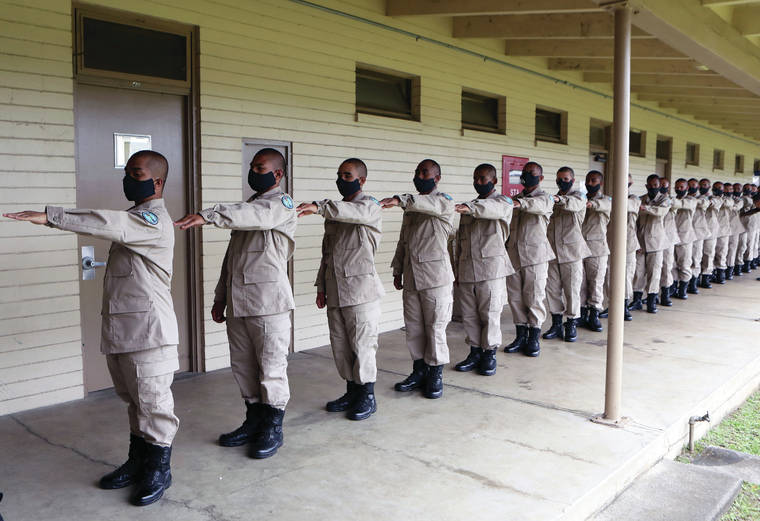Don’t close the book on the Hawaii National Guard’s Youth Challenge Academy in Hilo just yet — although a presentation by the state’s adjutant general to lawmakers earlier in the week gave the impression the program is dead in the budgetary water.
Bruce E. Oliveira, a retired brigadier general and the Hawaii Department of Defense’s community program director, said in an email Thursday, “The current plan is to continue operations in Hilo.”
“This is not a done deal,” Oliveira said. “The budget process will require the bill to go through our state Legislature to ratify or amend. If both chambers agree to add Hilo back into the budget, the governor can veto. If vetoed, the Legislature may override with sufficient vote.”
A veto override would require 2/3 of the vote in each chamber.
Maj. Gen. Kenneth S. Hara told a joint informational briefing of the Ways and Means and Public Safety, Governmental and Military Affairs committees Tuesday the program would close because of requested budget cuts by Gov. David Ige related to the COVID-19 pandemic.
The Hilo campus of the program for at-risk high-school-age youth, has about a $3 million yearly operating budget, with almost $2.4 million, or 75%, financed by the federal government. The remaining $612,000 comes from the state.
Hara told the senators the order to cut the budget is forcing the state’s DOD to “divest certain activities that are not focused on the department’s core function.”
If the campus were to be closed because the state didn’t allocate its portion of funding, the unused federal funds — which by agreement can only be used for Youth Challenge Academy — would have to be returned to the feds.
The Youth Challenge Academy has two locations, at Kalaeloa on Oahu’s Ewa plain — the site of the former Naval Air Station Barbers Point — and at Keaukaha Military Reservation near Hilo International Airport.
The program takes a military approach to education with academic, community service, job skills, citizenship, leadership, life skills, healthy living and physical fitness components.
The Hilo program, which recruits cadets from all neighbor islands, started in 2010 and was originally based at Kulani Correctional Facility about 20 miles southwest of Hilo on the slopes of Mauna Loa. The program moved to its current location in 2014.
Both campuses have two five-month classes per year. The most recent Hilo class graduated in December. Another class, with 62 candidates, is scheduled to begin next week, with graduation scheduled for June. Hara told lawmakers that class would be starting, regardless.
The classes are in a COVID bubble at this time, which means cadets are not permitted to leave the campus, and parents or guardians not being allowed to visit them during the duration of the class.
Cadets from Hilo’s Youth Challenge Academy are visible participants at community events, including parades. They’ve also provided logistical support, plus color guards, at Memorial Day and Veterans Day events in Hilo.
Hara’s pronouncement at Tuesday’s briefing appeared to take the senators by surprise. Sen. Lorraine Inouye, whose district includes Hamakua and portions of Hilo and Kohala, said that a shutdown of the Hilo campus would be “just so sad.”
“The campus is in with the National Guard, and it’s a nice place,” said Inouye, who sits on the Ways and Means Committee.
Oliveira said Kalaeloa has a capacity of 200 students per class, although classes generally don’t run that large and decline in size while in progress due to attrition. If Hilo and Kalaeloa were to combine at this time, there would be about 140 cadets.
Should the Hilo program fall to the budget ax, its campus would be returned to the Hawaii Army National Guard for other operational purposes.
Email John Burnett at jburnett@hawaiitribune-herald.com.






